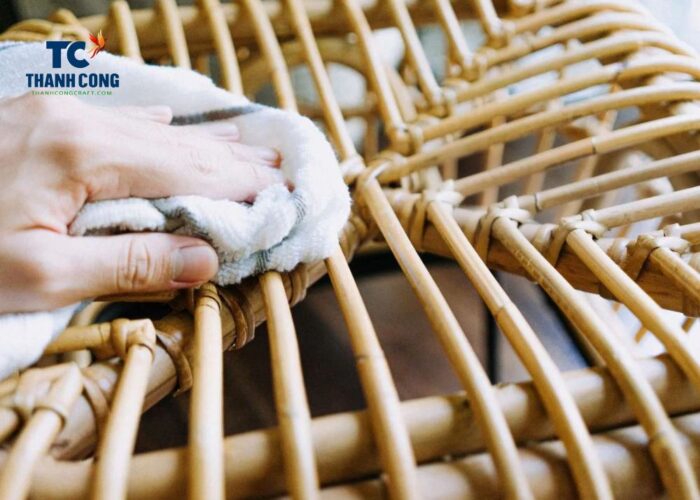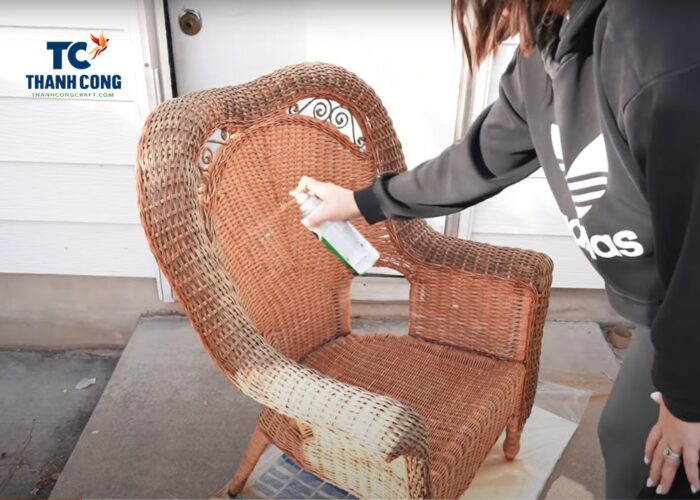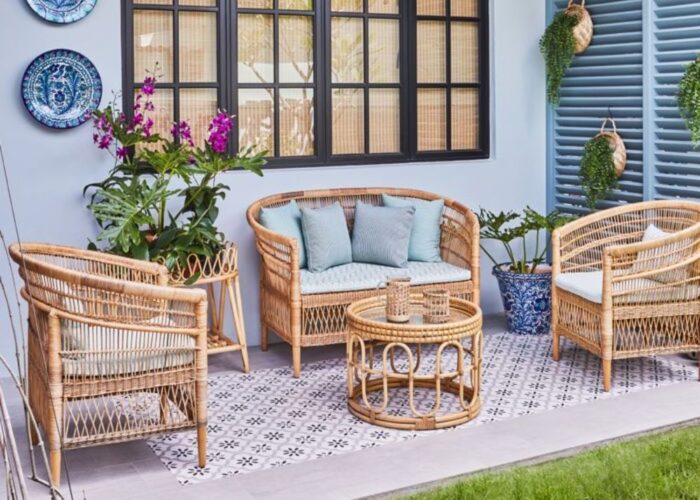Rattan furniture is a popular choice for many people because of its natural beauty, durability and easy maintenance. However, after a period of use, a rattan furniture can become yellowed, dusty and moldy. So, how to make old wicker furniture look fresh and bright again?
In this article, we will guide you on how to make rattan furniture look new. Have a read!
1. How to make rattan furniture look new?
Rattan is a natural, durable and beautiful material, used to make many types of furniture such as chairs, tables, beds, cabinets, shelves… However, over time, rattan can become yellow, peel, lose its shine and harden. To fix these damages and make wicker/ rattan furniture look fresher, you can refer these following ways:
1.1 Clean your rattan furniture
You can use baking soda, vinegar with a soft brush to wipe off dust and stains on the surface of rattan. Then, let it dry or air dry in a well-ventilated space.

1.2 Change your rattan furniture’s color
To remove varnish from rattan furniture and apply a new coat of paint, follow these steps:
- Use a paintbrush to apply the stripper evenly over the rattan.
- Cover the treated area with plastic wrap.
- Wait for the stripper to work (15-30 minutes).
- Use a scraper to gently remove the softened varnish.
You can choose the paint color that suits your style and space. You should use oil or acrylic paint to have high adhesion and scratch resistance. You should paint 2-3 layers to ensure good coverage and spray stain.

1.3 Decorate them with some items
You can create focal points for rattan furniture by adding details such as cushions, pillows, throws, patterns, or other accessories. Opt for bright and harmonious colors to create a warm and vibrant space.
Most importantly, avoid exposing rattan furniture directly to sunlight, high temperatures, or excessive humidity. Regularly wipe the furniture to keep the rattan clean and shiny.

2. FAQs
2.1 How do you prolong the life of rattan furniture?
To prolong the life of rattan furniture, several practices can be employed.
- Avoid Direct Sunlight: Prolonged exposure to direct sunlight can cause rattan to become brittle and lose its natural luster. Place the furniture in shaded areas or use curtains and blinds to protect it from harsh sunlight.
- Regular Cleaning: Clean the furniture regularly with a soft cloth or a vacuum cleaner to remove dust and debris. For more thorough cleaning, use a damp cloth with a mild detergent. Avoid using strong chemicals that may damage the rattan.
- Avoid Excessive Moisture: While rattan can withstand some moisture, excessive humidity or damp conditions can lead to mold and mildew. Keep the furniture in a well-ventilated area and use a dehumidifier if necessary, especially in humid climates.
- Use Cushions and Covers: To protect rattan from stains and spills, use cushions and covers. This not only adds comfort but also acts as a barrier against potential damage.
- Rotate and Rearrange: Rattan furniture may wear unevenly if used in the same way for an extended period. To distribute wear more evenly, rotate cushions and rearrange the furniture periodically.
- Avoid Dragging: When moving rattan furniture, lift it instead of dragging to prevent scratching or damaging the legs. Use furniture sliders or pads underneath to make it easier to move without causing harm.
- Apply a Protective Finish: Consider applying a protective finish, such as a clear lacquer or wax, to the rattan surface. This can provide an extra layer of protection against wear and tear.
- Store Indoors During Harsh Weather: If possible, store rattan furniture indoors during extreme weather conditions, such as heavy rain or winter storms. This helps prevent water damage and ensures the longevity of the furniture.
2.2 Why has my rattan furniture gone brittle?
There are several potential reasons why rattan furniture may become brittle over time:
- Exposure to Sunlight: Prolonged exposure to direct sunlight can cause rattan to dry out and become brittle. UV rays can strip the natural oils from the rattan, leading to a loss of flexibility and strength.
- Lack of Moisture: Rattan needs a certain level of moisture to maintain its flexibility and prevent it from drying out. If the furniture is placed in a very dry environment or is not regularly moisturized, it may become brittle.
- Age: Over time, all materials, including rattan, can naturally degrade. The aging process might result in a loss of elasticity and strength, making the furniture more susceptible to becoming brittle.
- Poor Quality or Treatment: If the rattan used in the furniture is of low quality or has not been properly treated, it may be more prone to drying out and becoming brittle.
- Environmental Conditions: Extreme temperature fluctuations or humidity levels can affect rattan. Drastic changes in environmental conditions, especially in uncontrolled environments, may contribute to the deterioration of rattan furniture.
- Improper Cleaning: Harsh cleaning chemicals or excessive moisture during cleaning can strip away natural oils and contribute to the drying out of rattan, making it more likely to become brittle.
2.3 What are the disadvantages of rattan furniture?
While rattan furniture has several advantages, it also comes with some disadvantages. Here are some potential drawbacks to consider:
- Vulnerability to Weather: Rattan is a natural material and is susceptible to damage from extreme weather conditions. Prolonged exposure to rain, sunlight, and humidity can lead to deterioration, discoloration, and a decrease in the furniture’s lifespan.
- Not Fully Weatherproof: Unlike some synthetic outdoor furniture materials, natural rattan is not completely weatherproof. It may require additional care, such as protective coatings or storage during harsh weather, to prevent damage.
- Fragility: While rattan is lightweight and flexible, it can be relatively fragile. Excessive weight or rough handling may cause it to crack or break, especially in comparison to more robust materials like metal or hardwood.
- Maintenance Requirements: Rattan furniture demands regular maintenance to preserve its appearance and durability. Cleaning and protecting it from environmental factors are essential to prevent issues like mold, mildew, or brittleness.
- Indoor Use Only: While some types of rattan furniture are suitable for outdoor use, many are better suited for indoor environments. This limitation may restrict its versatility for those looking to furnish outdoor spaces.
- Cost: High-quality rattan furniture can be relatively expensive compared to certain synthetic alternatives. However, it’s essential to balance the cost with the longevity and aesthetic appeal that rattan can provide.
- Susceptibility to Pests: Rattan is a natural material, making it potentially attractive to pests such as insects or rodents. Proper care and maintenance are necessary to prevent infestations.
If you have any further questions, don’t hesitate to send thanhcongcraft an email us at info@thanhcongcraft.com or message us at WhatsApp: +84967485411. Hope to serve you soon! Best regard!


